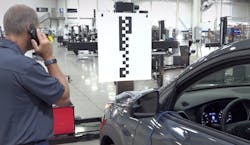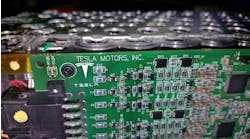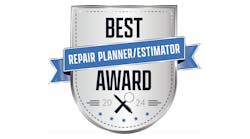Content brought to you by ABRN. To subscribe, click here.
What you will learn:
• The first ADAS feature was introduced more than 70 years ago
• More than 60 percent of new cars sold in the United States had advanced lane assist technology
• If there is enough ROI to justify the upfront cost of updating your current shop for ADAS, start exploring the best equipment/training for your shop.
A vehicle’s advanced driver assistance system (ADAS) has come a long way since it was first introduced more than 70 years ago, with the adoption of the anti-lock brake system and modern cruise control. Within the last few years, new ADAS functionalities, such as lane keeping assistance, blind spot warning and forward collision warning, have helped drivers safely get from point A to point B.
ADAS functionality not only makes driving safer; it has also simplified this very mundane experience. With advanced technology, today’s drivers expect more and more, especially with the market’s newest vehicles. We saw this in the first half of 2021, when more than 60 percent of new cars sold in the United States had advanced lane assist technology. We also know that ADAS is currently implemented in roughly one out of 10 cars worldwide. Although that may seem like a small number, don’t let it fool you — technological advancements for our motor vehicles show no signs of slowing down. Not only that, but consumers are continuing to expect high levels of ADAS in used vehicles and are even hungrier for cutting-edge advancements in new vehicles.
While consumers continue to marvel on the market’s latest and greatest functionalities, it’s hard not to think when ADAS will become standard for all vehicles. In earlier predictions, the industry foresaw that by 2022, drivers could expect that ADAS features would be implemented in nearly every new vehicle sold in the developing world. However, in March of 2021, a study by Roland Berger proved that prediction had shifted stating that that level of previously thought adoption would not be achieved until 2025.
There are several reasons for the delay in adoption, and the pandemic is indeed a main culprit. Since 2019, the industry has seen a steady decrease in vehicle sales year-over-year, so much so that in 2020, the United States dipped under 15 million vehicles sold in a year for the first time since 2011. And with the worldwide “chip” shortage, technology can barely keep up with the consumer demands of new high-tech vehicles. These two factors alone have played their part in slowing down the production of high-end ADAS vehicles.
Predictions now show that in 2025, 85 percent of vehicles produced globally will have some level of driving automation, and 50 percent of cars in use will have ADAS features by the end of 2030. Basic driver assistance like front radars and cameras are still expected to become standard over the next few years. However, with the challenges faced in today’s world, we do not foresee highly automated or fully automated features to achieve anything more than one percent penetration by that 2025 prediction.
So, what does this all mean?
As technological advances continue to be an integral piece in the standard vehicle, it’s become increasingly apparent that a world of fully equipped ADAS vehicles could be just within arm’s reach. Historically, ADAS functionalities grew alongside some of the most luxurious vehicles. We saw that more money meant more functionality and more exclusivity in getting you from where you are to where you need to be in comfort and high-end style. As ADAS shifts from being a luxury offering for a select few, to an affordable option for the mass market, shops worldwide must prepare for a new generation of standard vehicles.
For those in the field, we know that this is not a simple task. As we evaluate our shops, it’s easy to get overwhelmed by the updates needed for both old and new equipment, especially when we see the mounting dollar sign that rises steadily alongside it. A world full of ADAS-equipped vehicles won’t be rolling into your shop tomorrow, but that does not mean we should stall on planning. Small steps are crucial when it comes to preparing for the next few years. To help you get started, here are three ways your shop can prepare for a future of ADAS vehicles.
1. Determine the business fit
Since we know that a full level of ADAS adoption won’t be knocking on our doorsteps tomorrow, there are two options when considering how to service today’s ADAS equipped vehicles. Shops can either purchase the tools needed to bring the service in-house or they can rely on a third party to get the job done.
It’s important to evaluate your current intake of ADAS vehicles. How many high-caliber ADAS vehicles does your shop see in a week? What about a month? What available tools does your shop have now? What are you currently missing? What would it take to update your existing equipment, and what does the market look like for purchasing that newly needed equipment? Does your shop have an ADAS expert to tap when needed? These are important questions to ask before making a decision.
Then, it’s time to add up the numbers. Is there enough ROI to justify the upfront cost of updating your current shop? If the answer is no, it may be time to research third party ADAS repair vendors. And if it checks out, start exploring the best equipment for your shop.
2. Consider the best equipment for the job
If you have found that your shop is ready to offer ADAS services in-house, your next step is to find the right equipment. Like any new equipment purchase, it’s important to take the time to weigh and understand the options available. My recommendation is to find a system that harnesses the power of automation.
Calibration tools that require a manual setup significantly slow down cycle times and increase the chances for human error to occur. With that, technicians must understand what’s at stake if they aren’t repairing, recalibrating, and testing vehicles accurately before sending them back out on the road. It’s crucial that your system performs quick, repeatable and error-free calibrations to keep jobs moving safely.
OEMs are continually making tweaks and adjustments to their vehicles coming off the line. You will want to find a system that works with you, not against you. Find a calibration tool that gives you access to the latest OEM specs automatically – not one that empties your pockets with each new update. Millimeters matter in ADAS calibration, and even the smallest error not only risks the driver’s safety, but others’ safety on the road, too.
The key takeaway? Invest in a system the makes life easier, completes jobs quicker and has proven accuracy your team can trust every time.
3. Training, training… and more training
One of the biggest challenges the industry faces when it comes to accurate ADAS repairs is training. If shops are not investing in today’s proper training from day one, they open the door for unnecessary expenses and increased risk down the road.
It’s important that your shop finds a system that requires certified training before you are able to use the tool. This allows you and your technicians to build a bulletproof process to ensure calibration repairs are following protocol and are completed correctly. Additionally, you will want a tool supplier that continues to be a partner in your ADAS training even after your initial onboarding. Ideally, your system would provide additional remote support (free of charge) moving forward if technicians have questions.
As we look toward the future of repair shops, we know that yesterday’s answers won’t solve tomorrow’s problems. With technology at the forefront of all that we do, it’s important now more than ever to stay ahead of the curve and prepare for what’s next, which is a world full of highly equipped ADAS vehicles.



